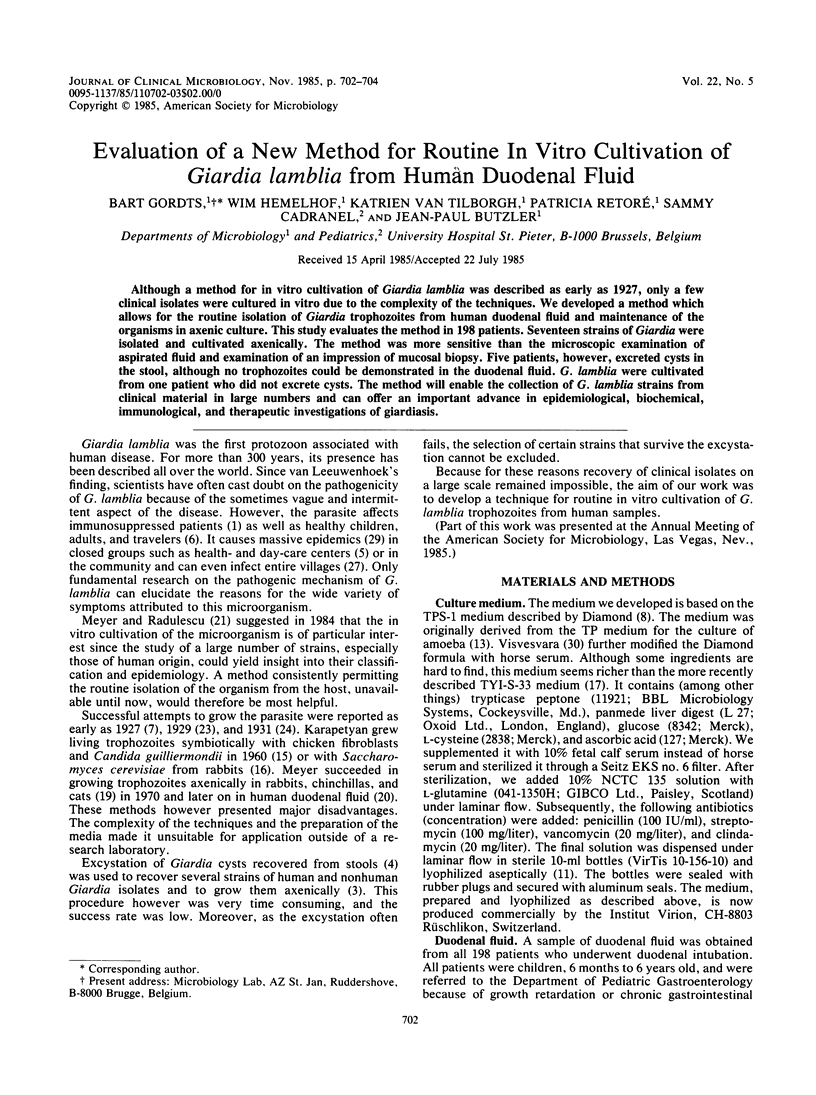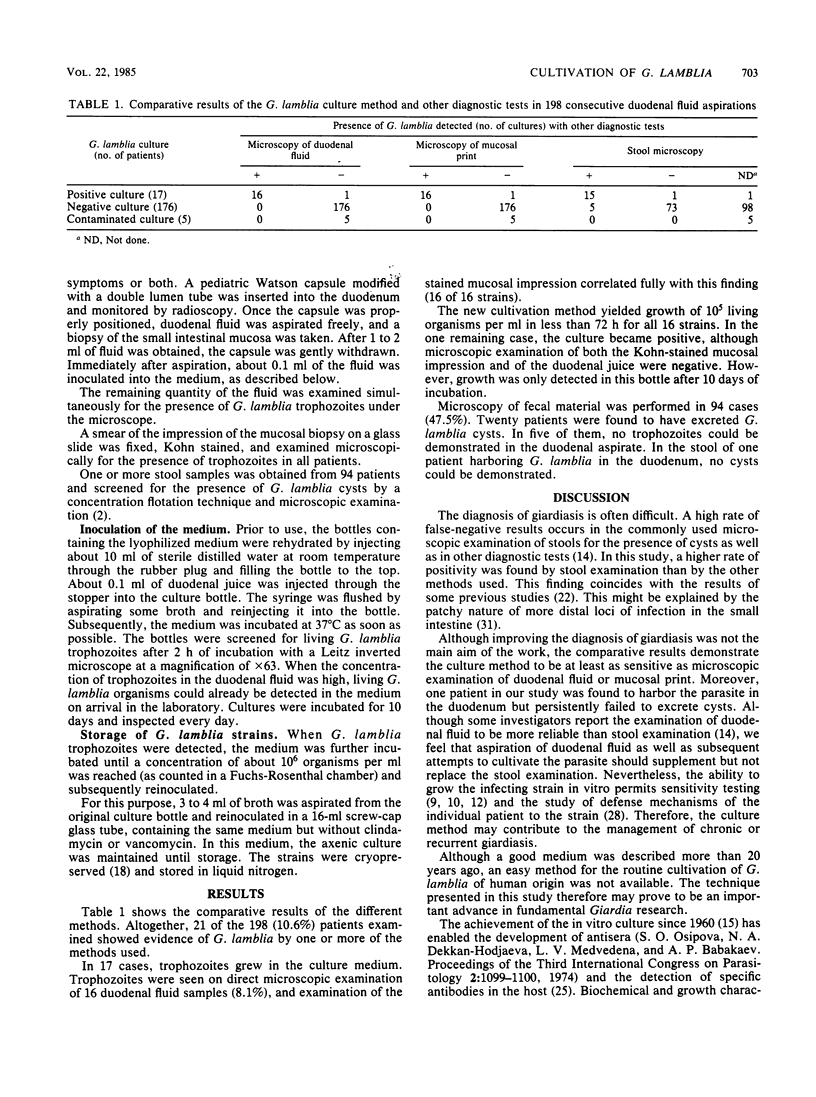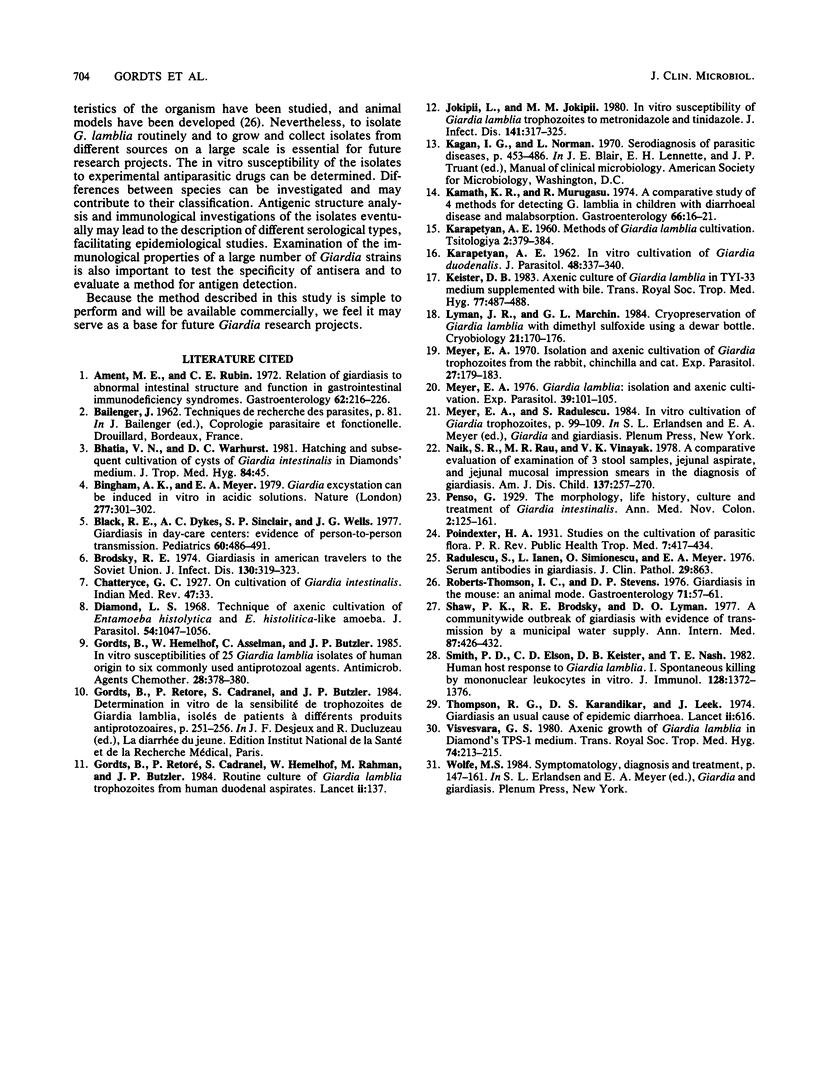Abstract
Although a method for in vitro cultivation of Giardia lamblia was described as early as 1927, only a few clinical isolates were cultured in vitro due to the complexity of the techniques. We developed a method which allows for the routine isolation of Giardia trophozoites from human duodenal fluid and maintenance of the organisms in axenic culture. This study evaluates the method in 198 patients. Seventeen strains of Giardia were isolated and cultivated axenically. The method was more sensitive than the microscopic examination of aspirated fluid and examination of an impression of mucosal biopsy. Five patients, however, excreted cysts in the stool, although no trophozoites could be demonstrated in the duodenal fluid. G. lamblia were cultivated from one patient who did not excrete cysts. The method will enable the collection of G. lamblia strains from clinical material in large numbers and can offer an important advance in epidemiological, biochemical, immunological, and therapeutic investigations of giardiasis.
Full text
PDF


Selected References
These references are in PubMed. This may not be the complete list of references from this article.
- Ament M. E., Rubin C. E. Relation of giardiasis to abnormal intestinal structure and function in gastrointestinal immunodeficiency syndromes. Gastroenterology. 1972 Feb;62(2):216–226. [PubMed] [Google Scholar]
- Bhatia V. N., Warhurst D. C. Hatching and subsequent cultivation of cysts of Giardia intestinalis in Diamond's medium. J Trop Med Hyg. 1981 Feb;84(1):45–45. [PubMed] [Google Scholar]
- Bingham A. K., Meyer E. A. Giardia excystation can be induced in vitro in acidic solutions. Nature. 1979 Jan 25;277(5694):301–302. doi: 10.1038/277301a0. [DOI] [PubMed] [Google Scholar]
- Black R. E., Dykes A. C., Sinclair S. P., Wells J. G. Giardiasis in day-care centers: evidence of person-to-person transmission. Pediatrics. 1977 Oct;60(4):486–491. [PubMed] [Google Scholar]
- Brodsky R. E., Spencer H. C., Jr, Schultz M. G. Giardiasis in American travelers to the Soviet Union. J Infect Dis. 1974 Sep;130(3):319–323. doi: 10.1093/infdis/130.3.319. [DOI] [PubMed] [Google Scholar]
- Diamond L. S. Techniques of axenic cultivation of Entamoeba histolytica Schaudinn, 1903 and E. histolytica-like amebae. J Parasitol. 1968 Oct;54(5):1047–1056. [PubMed] [Google Scholar]
- Gordts B., Hemelhof W., Asselman C., Butzler J. P. In vitro susceptibilities of 25 Giardia lamblia isolates of human origin to six commonly used antiprotozoal agents. Antimicrob Agents Chemother. 1985 Sep;28(3):378–380. doi: 10.1128/aac.28.3.378. [DOI] [PMC free article] [PubMed] [Google Scholar]
- Gordts B., Hemelhof W., Retoré P., Rahman M., Cadranel S., Butzler J. P. Routine culture of Giardia lamblia trophozoites from human duodenal aspirates. Lancet. 1984 Jul 21;2(8395):137–138. doi: 10.1016/s0140-6736(84)91050-x. [DOI] [PubMed] [Google Scholar]
- Jokipii L., Jokipii A. M. In vitro susceptibility of Giardia lamblia trophozoites to metronidazole and tinidazole. J Infect Dis. 1980 Mar;141(3):317–325. doi: 10.1093/infdis/141.3.317. [DOI] [PubMed] [Google Scholar]
- KARAPETYAN A. In vitro cultivation of Giardia duodenalis. J Parasitol. 1962 Jun;48:337–340. [PubMed] [Google Scholar]
- Kamath K. R., Murugasu R. A comparative study of four methods for detecting Giardia lamblia in children with diarrheal disease and malabsorption. Gastroenterology. 1974 Jan;66(1):16–21. [PubMed] [Google Scholar]
- Keister D. B. Axenic culture of Giardia lamblia in TYI-S-33 medium supplemented with bile. Trans R Soc Trop Med Hyg. 1983;77(4):487–488. doi: 10.1016/0035-9203(83)90120-7. [DOI] [PubMed] [Google Scholar]
- Lyman J. R., Marchin G. L. Cryopreservation of Giardia lamblia with dimethyl sulfoxide using a Dewar flask. Cryobiology. 1984 Apr;21(2):170–176. doi: 10.1016/0011-2240(84)90208-6. [DOI] [PubMed] [Google Scholar]
- Meyer E. A. Giardia lamblia: isolation and axenic cultivation. Exp Parasitol. 1976 Feb;39(1):101–105. doi: 10.1016/0014-4894(76)90016-3. [DOI] [PubMed] [Google Scholar]
- Meyer E. A. Isolation and axenic cultivation of Giardia trophozoites from the rabbit, chinchilla, and cat. Exp Parasitol. 1970 Apr;27(2):179–183. doi: 10.1016/0014-4894(70)90023-8. [DOI] [PubMed] [Google Scholar]
- Roberts-Thomson I. C., Stevens D. P., Mahmoud A. A., Warren K. S. Giardiasis in the mouse: an animal model. Gastroenterology. 1976 Jul;71(1):57–61. [PubMed] [Google Scholar]
- Shaw P. K., Brodsky R. E., Lyman D. O., Wood B. T., Hibler C. P., Healy G. R., Macleod K. I., Stahl W., Schultz M. G. A communitywide outbreak of giardiasis with evidence of transmission by a municipal water supply. Ann Intern Med. 1977 Oct;87(4):426–432. doi: 10.7326/0003-4819-87-4-426. [DOI] [PubMed] [Google Scholar]
- Smith P. D., Elson C. O., Keister D. B., Nash T. E. Human host response to Giardia lamblia. I. Spontaneous killing by mononuclear leukocytes in vitro. J Immunol. 1982 Mar;128(3):1372–1376. [PubMed] [Google Scholar]
- Thompson R. G., Karandikar D. S., Leek J. Giardiasis. An unusual cause of epidemic diarrhoea. Lancet. 1974 Apr 6;1(7858):615–616. doi: 10.1016/s0140-6736(74)92664-6. [DOI] [PubMed] [Google Scholar]
- Visvesvara G. S. Axenic growth of Giardia lamblia in Diamond's TPS-1 medium. Trans R Soc Trop Med Hyg. 1980;74(2):213–215. doi: 10.1016/0035-9203(80)90249-7. [DOI] [PubMed] [Google Scholar]


